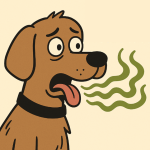
Mushrooms and Your Dog: A Hidden Danger in the Outdoors
When it comes to keeping our furry companions safe, we often think of dangers like traffic, heat, or harmful foods. But one overlooked risk is lurking in your backyard, parks, and forests: mushrooms. While many mushrooms are harmless, some species can cause serious health issues for dogs, ranging from mild gastrointestinal upset to life-threatening organ failure. A recent study (link will download a .pdf) conducted by the Norwegian Poison Information Center sheds light on the risks associated with mushroom ingestion in dogs, based on over a decade of data (2011-2022). The findings provide valuable insights for pet owners about how to prevent and handle mushroom poisonings.
Understanding the Risks: Why Dogs Eat Mushrooms
Dogs are naturally curious creatures, and their sense of smell often leads them to explore the world through taste. Unfortunately, this can include mushrooms growing in yards, gardens, and woodland areas. While only a small percentage of mushroom species are toxic, the ones that are can be extremely dangerous. The study analyzed 421 cases of mushroom ingestion by dogs, identifying both the types of mushrooms involved and the outcomes for the dogs. Surprisingly, about 45% of these ingested mushrooms were harmless, but for those that weren’t, the results could be dire.
What Happens When a Dog Eats a Toxic Mushroom?
The effects of mushroom poisoning in dogs can vary significantly depending on the type of mushroom. Some may cause only mild stomach upset, while others can lead to severe symptoms or even death. According to the study, the majority of dangerous mushrooms fell into three categories: gastrointestinal irritants, muscarinic mushrooms, and isoxazole-containing mushrooms. Here’s what that means for your dog:
- Gastrointestinal irritants: The most common group, these mushrooms caused vomiting and diarrhea in 28% of dogs that ingested them. While these symptoms are unpleasant, most cases were mild, and the dogs recovered within a few days. However, it’s still important to monitor your pet closely if they eat any wild mushroom, as even mild symptoms can escalate if untreated.
- Muscarinic mushrooms: Mushrooms in this group, such as Clitocybe and Inocybe species, affect the nervous system. Common signs include drooling, vomiting, diarrhea, and lethargy. In severe cases, the poison can cause tremors or difficulty breathing, requiring immediate veterinary intervention. The study found that 83% of dogs that ingested muscarinic mushrooms had been eating mushrooms growing in gardens, highlighting the importance of inspecting your yard regularly.
- Isoxazoles (e.g., Amanita muscaria): These mushrooms are among the most toxic and can cause serious neurological symptoms like seizures, restlessness, and even death. Two fatal cases were recorded after ingestion of Amanita muscaria, a striking red-capped mushroom that might attract a curious dog. This highlights the importance of quick action—if you suspect your dog has ingested an isoxazole-containing mushroom, get to the vet immediately.
Fast Action Can Save Lives
One of the most critical findings from the study is that early identification of the mushroom and quick veterinary treatment dramatically improve outcomes. Overall, the survival rate in the study was 98.6%, which is encouraging. The study suggests that 64% of dogs were managed at home, while 33% were hospitalized and received treatment. This means if you catch the ingestion early, your dog has a very high chance of recovery.
For many pet owners, the thought of their dog eating something harmful is terrifying. But knowing what to look out for can make all the difference. If your dog eats a mushroom and you’re unsure of its safety, here’s what to do:
- Act quickly: Remove any remaining mushroom from your dog’s mouth and keep a sample if possible. This will help your vet identify the species.
- Watch for symptoms: Vomiting, drooling, lethargy, and diarrhea are the most common signs of mushroom poisoning. More severe symptoms include tremors, seizures, or trouble breathing.
- Call your vet or a poison control center: Even if your dog seems fine, it’s important to seek professional advice. The Norwegian Poison Information Center provided invaluable support in this study, and similar services are available worldwide.
- Don’t wait for symptoms to worsen: Some toxins can take hours or even days to cause serious damage, especially to the liver and kidneys. Early intervention is key.
Prevention Is Key
One of the simplest ways to prevent mushroom poisoning is by keeping an eye on your dog’s environment. Regularly inspect your yard and any areas where your dog plays or walks, especially during mushroom season (late summer and fall). Mushrooms tend to pop up after rain, so be extra cautious during these periods.
Training your dog to avoid eating things off the ground can also help, although it’s not foolproof. Supervision is crucial, especially with puppies and younger dogs, who were found to be more likely to ingest mushrooms in the study.
Join the Conversation
Have you ever had a close call with your dog eating something toxic? What steps do you take to protect your pet from potential hazards in the environment? Share your experiences and tips in the comments below or join us on social media using #PetSafety and #DogHealth to spread awareness about this important issue!




